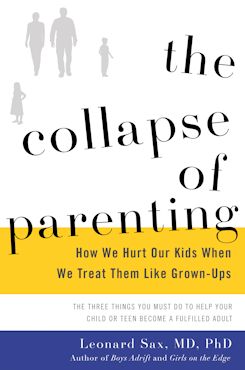
|
October 26, 2016
Book: The Collapse of Parenting: How we hurt our kids when we treat them like grown-ups Author: Leonard Sax, MD Basic Books. A member of the Perseus Books Group. New York. 2016. Pp. 287 An Excerpt from the Jacket:
In the Collapse of Parenting, physician, psychologist and internationally acclaimed author Leonard Sax presents data documenting a dramatic decline in the achievement and psychological health of American children. Sax argues that rising levels of obesity, depression, and anxiety among young people --- as well as the explosion in prescribing psychiatric mediations to kids --- can all be traced to parents letting their kids call the shots. Many parents are afraid of seeming too dictatorial and end up abdicating their authority rather than taking a stand with their children. If kids refuse to eat anything green and demand pizza instead, some parents give in, inadvertently raising children who are more likely to become obese. If children are given smartphones and allowed to spend the bulk of their free time texting, playing video games, and surfing the Internet, they become increasingly reliant on peers and the media for guidance on how to live, rather than getting such guidance at home. And if they won't sit still in class or listen to adults, they're often prescribed medication, a quick fix that actually undermines their self-control. In short, Sax argues parents are failing to prioritize the parent-child relationship and are allowing a child-peer dynamic to take precedence. The result is children who have no absolute standard of right and wrong, who lack discipline, and who look to their peers and the Internet for direction, instead of looking to their parents. But there is hope. Sax shows how parents can help their kids by reasserting their authority --- by limiting time with screens, by encouraging better habits at the dinner table and bedtime, and by teaching humility and perspective. Drawing on more than twenty-five years of experience as a family physician and psychologist, along with hundreds of interviews with children, parents, and teachers across the United States and around the world, Sax offers a blueprint parents can use to refresh and renew their relationships with their children to help their children thrive in an increasingly complicated world. An Excerpt from the Book: I can tell you many stories which are similar to Aaron's story and Julia's story, stories which have been related to me by parents or that I have observed firsthand in my role as a physician. The common thread connecting Aaron the out-of-shape gamer to Julia the would-be engineer is fragility. When Arron came home from the tryout, why didn't he take up the coach's challenge and return to try harder? When Julia discovered that she wasn't as smart as she thought, why did she collapse? The answer in both cases is that these kids are fragile. It doesn't take much for them to give up and retreat, as Aaron did, or to fall apart as Julia did. Fragility has become a characteristic of American children and teenagers to an extent unknown 25 years ago. That's what I'm seeing in the office today --- and what I did not see in the office years ago. But besides my observations and experience as a physician over the past quarter century, several lines of evidence support my claim that young Americans are more fragile in comparison with young Americans from two or three decades ago. The first and most obvious evidence is the extraordinary rise in the proportion of young Americans diagnosed with a psychiatric disorder, compared to young people in other countries today and compared to young people in this country 30 years ago. That line of evidence is relevant in Julia' case, since two board-certified physicians --- a pediatrician and a psychiatrist --- treated her with mediation for depression. But that line of evidence doesn't pertain in Aaron's case. Nobody has diagnosed Aaron with anything. In fact Aaron is a pretty guy, as long as you don't interrupt him while he's playing his video game. But Aaron and Julia do share something in common. In each case, something inside seems to be missing: some inner strength that we took for granted in young people a few decades back but that just didn't develop in these two. Table of Contents: Part One: Problems 1. The culture of disrespect 2. Why are so many kids overweight? 3. Why are so many kids on medication? 4. Why are American students falling behind? 5. Why are so many kids so fragile? Part Two: Solutions 6. What matters? 7. Misconceptions 8. The first thing: teach humility 9. The second thing: enjoy 10. The third thing: the meaning of life Conclusion |
|
